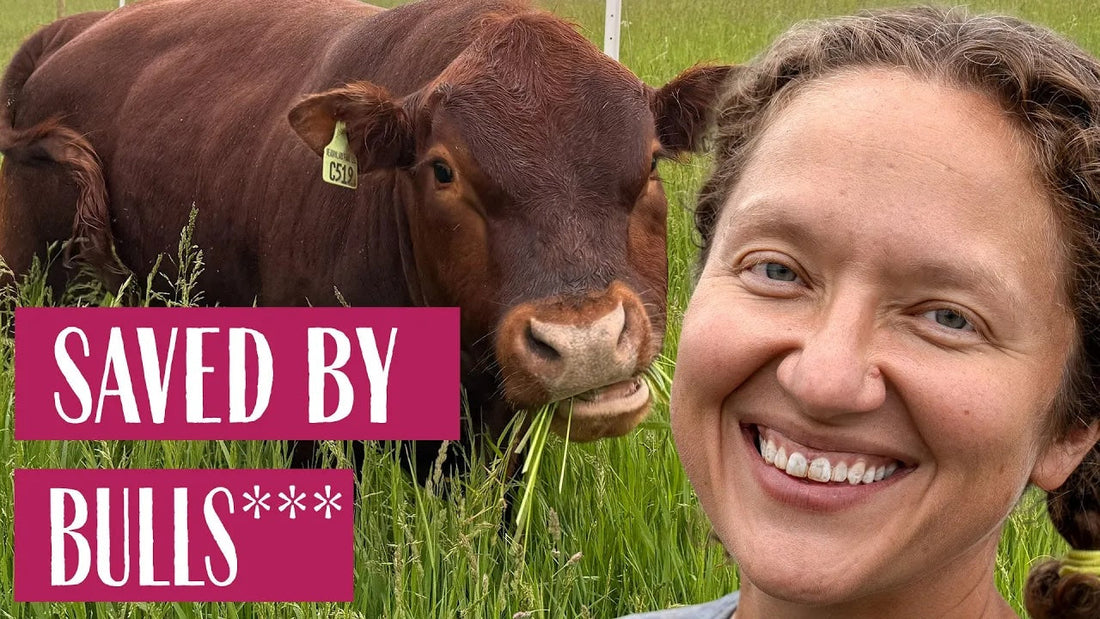
Saved by the Bull - Farmer Mary Field Notes (Week 36)
Share
➡️ Subscribe on Apple Podcasts
There are cycles and rhythms to so many of the things we do on the farm. In the winters we hide away like the squirrels and the rabbits, scurrying around in the cold to do the absolute minimum of outside work, but mostly waiting for the freezing cold to pass us by and enjoying a slower pace of life. We organize our nest, tinker, build things, fix things, maybe try our hand at a creative project or two (crochet, woodworking, fancy cooking). As spring creeps in, we watch the leaves unfurl and we begin to stretch ourselves, too, putting wintered-over plans into action and preparing for the growing season ahead. Summer is the peak–we shift like sunflowers, basking in the light of the long days, running full-tilt to tend to every growing thing on the farm and spending every bit of energy in our batteries, confident that we will greet the sun again and recharge them the next day. And now? Now I feel a bit crunchy and scorched, much as the parched grass does under my feet as the days without rain stretch on in this last gasp of summer. The morning air has an edge these days, reminding me that soon the season will turn, and the land will rest, and my focus will shift.
As we tread that meandering line between summer and fall, waiting for a respite from the heat but not wanting to wish it gone too soon, I watch that crunchy, stressed grass and feel my own stress level rise. On a regenerative farm, we watch the grass all year long. It’s what our animals eat, day in and day out, and we manage this precious resource with an intense focus. My primary job is making sure we have enough grass on the entire property for our animals to eat each day while still growing a reserve stockpile on those same pastures.
It’s a tricky balance–I want them to eat the best bite of each plant and move on, leaving the rest of the plant to grow back quickly. This is why I move temporary fences each day, judging on the fly how much the herds have eaten and whether they need a larger or smaller space to maintain that delicate balance. If they eat too far down on the plant, it loses root length and too much leaf and takes longer to regrow, plus it changes the balance of carbs and protein they get from each plant, which can throw off the animals’ GI tracts, limiting their weight gain and leaving them in sub-optimal health.
That said, have you looked at your lawn lately? Unless you’ve got a spectacular sprinkler system, I bet it looks as sad and brownish as mine does. Without more rain, our stockpile of grass doesn’t grow and we have less to feed the animals as winter comes on. So we hedge our bets. We’re buying hay from local farmers who match our practices–they don’t spray their fields, they grow the orchard grass mix that our animals eat every day, and they live nearby. We hook up a trailer and bring back loads of hay to stack in our barnyard to serve as a winter reserve. Ideally, we wouldn’t need any of it until much later, but the reality is, we fed our first bales this week in a strategic attempt to let our pastures rest longer and grow back stronger before we send the animals through again. It could be tempting to see this as a failure, but the truth is, we’re still building our pastures–they’re mostly run-out hayfields that need more nutrients, so letting the animals hang out and put down a bunch of manure and kinetic energy into the soil isn’t necessarily a bad thing. We stick them in our worst pastures, and let them fix it just by doing what comes naturally. It takes longer than spreading commercial chemicals or fertilizer, but we do see improvement every single time they move through a field, and there’s no cost or negative impacts (other than the cost of 4’x6’ round bales).
Ok, I’ve strung you along long enough with my strategic farmer talk. To the punchline. Yesterday, we transitioned from regular grass pastures into feeding hay, and not only did I need to move our main herd between pastures, I also needed to sort the animals. The ewes needed to move into the new space, the mama cows and the one calf needed to go with them, but the bull needed to stay behind–his job is done for now, so he can go hang out with the guys until it’s breeding season again. The problem? All I had was me, possibly the kids as backup, and a gate to sort them with. Often, they walk between pastures in a predictable pattern: sheep first, cows and bull next. My (very sketchy) plan was to let them do just that, but hope to catch the bull last and quickly shut the gate. That would keep him inside hard fencing (permanent posts and high-tensile wire) instead of relying on temporary fence (just plastic posts and some flexible wire) to keep him away from his four girlfriends.
I woke up with a pit in my stomach and didn’t even want to walk out the door. So I cheated, and did all the easy jobs first. Fed the horse, kissed his nose, talked to the turkeys, all the nice jobs. I loaded up a hay bale and put it in the herd’s intended pasture, set up their divider fence, laid the fence lane they would walk between the two pastures, and then, casually walked up to see where they were hanging out and whether my threadbare plan would work.
Ooh, sheep. Ok. Step one: turn off the fence in case I needed to bail over the side. Step two: open the gate. The sheep came running with the guard dog (Hi, Summer!) and took off down the lane to their new space. (A bonus of moving them so often is that an open gate is their cue to literally head to greener pastures. They know what’s happening.) Step 3: the cows start to figure out what’s up and gradually heave themselves up and start shuffling toward me. My heart rate increases, I try to breathe like a normal person so I don’t freak them out. The lead cow is on her way, the baby is hanging back. Like magic, all four cows are headed toward the gate, and the bull…has to take a poo.
The cows are through the gate, moving down the lane, and only the baby is hanging back. CLANG. Gate closed, I’ll figure out the baby afterward. Luckily, the kids roared up on Ez’s ATV moments later, and I convinced them to scramble over the fence to help herd the baby so he could squeak through the tiny space I opened up in the gate. Done. I expected this task to take at least an hour, and was fully expecting more drama. I called John to tell him the good news:
“You’ll never believe this. They went exactly in order! The bull was distracted because he had to poop!”
“Mar, do you know what you call that?”
“Divine intervention?”
“Close. Holy sh**.”
…yep. We plan, we prepare, and we pray. Sometimes, things work out better than we ever hope. You know, until ten minutes later when the baby popped through the temporary fence in the new pasture and we had to catch him. Farm life!
Probably, I should give you a beef recipe in honor of all the cow references today, but I’m going to give you something green and vibrant in the hopes that it will inspire the grass to grow a bit more. (Plus, it’s really good on beef!)
Chimichurri sauce is one of my favorites. It’s bright green, piquant in smell and flavor, and it brightens literally everything. Grill up a steak, make some white or brown rice, steam some broccoli, and this sauce will make it a meal. Just make sure you share–when one person eats garlic, the rest should, too. ;)
Chimichurri Sauce
Full disclosure: This one is adapted from Cook’s Illustrated. I often reduce the amount of olive oil to lighten it up, but that’s entirely your call!
Ingredients:
- Dried oregano: 2 tsp
- Hot water: ¼ cup
- Kosher salt: 1 tsp
- Fresh parsley: 1½ cups, finely chopped
- Fresh cilantro: ½ cup, finely chopped
- Scallions: 2, chopped
- Garlic cloves: 4, peeled and chopped
- Lemon juice: 1 tablespoon
- Red wine vinegar: ¼ cup
- Red pepper flakes: ½ tsp
- Olive oil: ½ cup
Instructions:
- In a small bowl, combine the hot water, dried oregano, and kosher salt. Allow the mixture to sit for about 5 minutes to brighten the flavor of the oregano.
- In a food processor, combine the chopped parsley, cilantro, scallions, garlic, and red pepper flakes. Pulse a few times until the ingredients are roughly chopped.
- Pour the oregano/water mixture, along with the red wine vinegar and lemon juice, into the food processor. Pulse a few times to combine.
- Transfer the mixture to a medium bowl.
- Gently whisk in the olive oil until a thick, emulsified consistency is achieved.
- Cover the bowl and allow the sauce to stand at room temperature for about 1 hour before serving to let the flavors meld. (I’m never this patient, but I figure it keeps nicely in the fridge and improves for leftovers the next day!)
